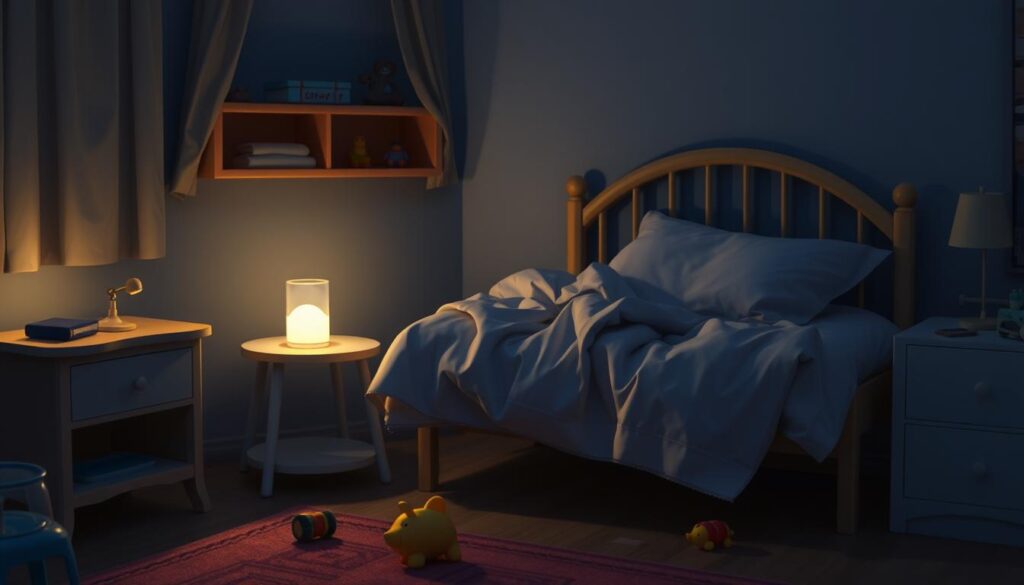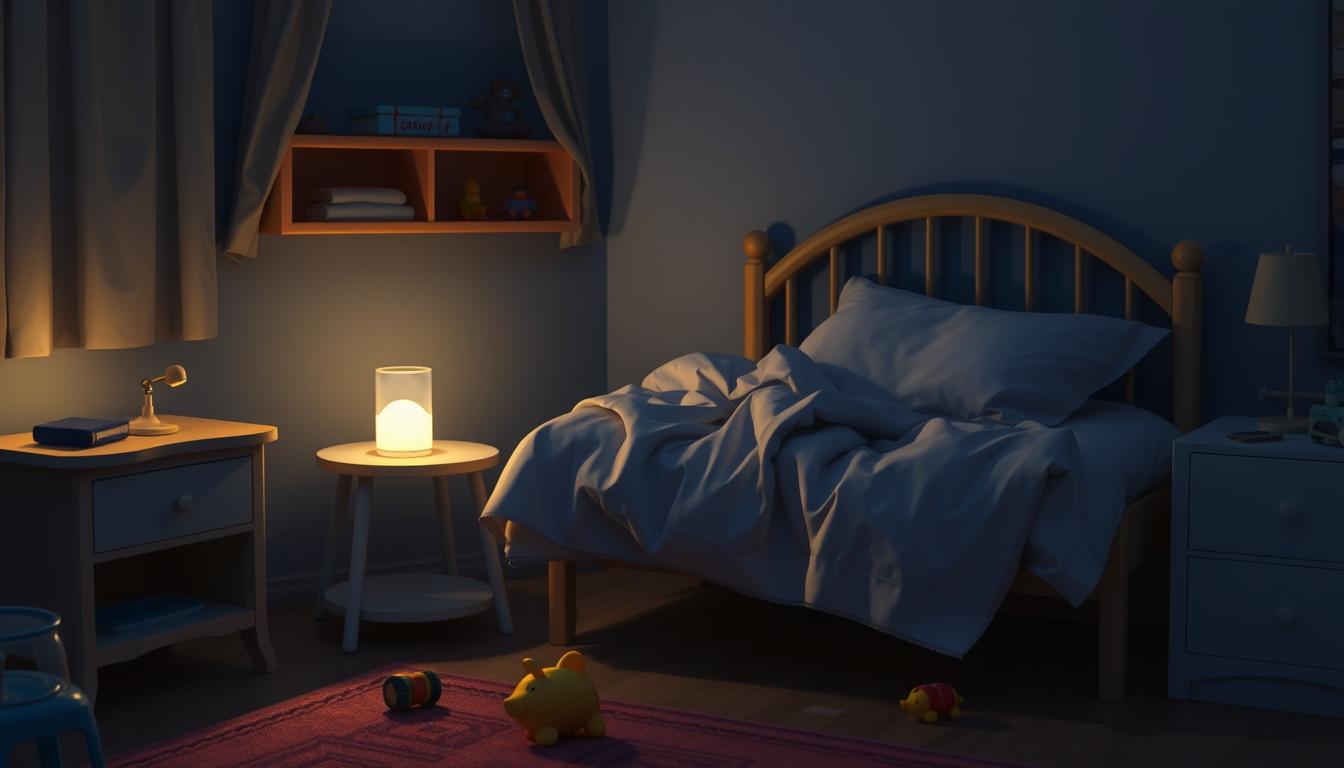Bedwetting, or nocturnal enuresis, is a common issue in kids. It can really affect a child’s self-esteem and family life. This guide will look at why bedwetting happens, how to fix it, and support for families facing this problem. We’ll talk about the physical and mental reasons behind bedwetting, discuss the right treatments for kids, and share ways to manage feelings and boost self-esteem.

Bedwetting: Causes, Solutions, and Support
Key Takeaways
- Bedwetting is a common childhood problem, affecting up to 15% of children in Australia.
- Both physiological and psychological factors can contribute to bedwetting, including bladder control issues and sleep patterns.
- Effective solutions, such as bedwetting alarms and moisture-wicking sheets, can help manage the issue and improve a child’s quality of life.
- Providing support and building self-esteem are crucial in helping children overcome the emotional challenges of bedwetting.
- Seeking professional help, such as from a doctor or continence specialist, can be beneficial in identifying the root cause and developing a tailored treatment plan.
Bedwetting: Causes, Solutions, and Support
Bedwetting, or nocturnal enuresis, is when a child pees without meaning to while they sleep. It can really hurt a child’s self-esteem and daily life. Knowing about bedwetting and how common it is can help parents and caregivers support their kids better.
What is Bedwetting?
Bedwetting is when a child pees without control during sleep. It’s quite common, affecting about 5-10% of 7-year-olds and up to 2% of teens. It might seem simple, but it can really upset both the child and their family.
Prevalence and Impact
Bedwetting is quite common, with studies showing it affects 15-20% of 5-year-olds and 5% of teens. It’s not just about the pee; it can really hurt a child’s feelings, making them feel embarrassed, low in self-esteem, and lonely. It also makes life hard for families, dealing with the practical and emotional sides of it.
“Bedwetting can have a profound impact on a child’s self-confidence and social development. It’s important for parents and caregivers to understand the prevalence of this issue and provide the necessary support.”
By being kind and understanding, families can help kids beat this challenge. This way, kids can grow up feeling confident and strong.
Causes of Bedwetting
Bedwetting, or nocturnal enuresis, is a common issue for kids and their families. Knowing what causes it can help find solutions. It mainly comes from physical and mental factors.
Physiological Factors
One main reason is when kids can’t control their bladder yet. As they grow, they learn to control their bladder better. But some grow slower. Also, if your family has a history of bedwetting, you might be more likely to have it too.
Sleep problems, like sleep apnea, can also cause bedwetting. They mess up sleep and make it hard to wake up when the bladder is full.
Psychological Factors
Emotions and behaviour can also play a big part. Stress, anxiety, and scary experiences can make it hard for kids to control their bladder. Bedwetting can also be caused by fears, like the dark, or feeling scared to be away from family.
| Physiological Factors | Psychological Factors |
|---|---|
| Developmental delays in bladder control Genetic predisposition Sleep disorders | Stress Anxiety Traumatic experiences Fear of the dark Separation anxiety Lack of confidence |
Knowing why bedwetting happens is key to finding the right treatment. By tackling both physical and mental reasons, families can help their kids overcome this issue.
“The key to managing bedwetting is to approach it with patience, understanding, and a willingness to explore the underlying causes.”
Bedwetting and Age
Bedwetting, or nocturnal enuresis, is common in young kids. Knowing when bladder control and toilet training should be mastered helps understand when bedwetting is a worry.
Children grow and learn bladder control and toilet training in stages. Most kids control their bladder during the day by 3 or 4. But, mastering nighttime bladder control takes longer. About 15-20% of kids still wet the bed at 5 years old.
- Bedwetting is most common in children aged 5-7 years old, with an estimated prevalence of around 15-20%.
- By the age of 10, the prevalence of bedwetting decreases to around 5-10%.
- In rare cases, bedwetting may persist into adolescence or adulthood, affecting less than 1-2% of the population.
Remember, every child develops bladder control at their own pace. Some might get it sooner, while others might take longer. As long as they’re making progress and it’s not causing them distress, it’s usually okay.
If a child is still wetting the bed when most of their friends have stopped, it’s time to get help. A doctor can check for any health or psychological issues. They can then suggest the best ways to help the child.
“Bedwetting is a normal part of a child’s development, and it’s important to be patient and supportive during this time.”
Identifying the Root Cause
Understanding why your child wets the bed is the first step to solving the problem. A thorough medical check and a bedwetting diary can help find the cause. This way, you can create a treatment plan that fits your child’s needs.
Medical Evaluation
A medical check is key to rule out any health issues that might cause bedwetting. Your doctor might do a physical check, order tests, or send you to a specialist. This ensures the treatment plan tackles the real cause of bedwetting.
Keeping a Bedwetting Diary
Keeping a detailed diary about bedwetting can give you and your doctor important insights. It helps track when and why bedwetting happens. This info is crucial for creating a treatment plan that really works.
| Bedwetting Diary: Key Information to Record |
|---|
| Time of bedwetting incidents Frequency of bedwetting Fluid intake before bedtime Stress levels or significant events Sleep patterns and quality Bathroom habits and bowel movements |
By working with your healthcare team and keeping a detailed diary, you can find out why your child wets the bed. Then, you can create a treatment plan that really helps.
Effective Solutions for Bedwetting
Bedwetting can be tough but not unbeatable. There are many ways to help kids deal with it. Bedwetting alarms and moisture-wicking sheets are two top choices.
Bedwetting Alarms
Bedwetting alarms are great for teaching the bladder to wake up when it’s time to go. They sound an alarm when they sense moisture. This helps the brain and bladder learn to work together, reducing bedwetting over time.
Moisture-Wicking Sheets
Moisture-wicking sheets are also a big help. They draw moisture away from the skin, keeping it dry and comfy. This prevents irritation and helps kids sleep better.
Using both bedwetting alarms and moisture-wicking sheets can tackle bedwetting from all angles. With the right approach, many kids can stop bedwetting and sleep well.
TO WATCH VIDEO CLICK HERE
“The key to managing bedwetting is finding solutions that address the root cause and provide practical support for the child and their family.”
Bedwetting and Toilet Training
Toilet training is a big step in a child’s life. It’s linked to bedwetting, which is important to understand. Knowing how toilet training affects bladder control helps solve bedwetting problems.
Toilet training starts when a child is 18-24 months old. At this time, their bladder control is still growing. They learn to feel when they need to pee and how to use the toilet. But, it can be tough, and some kids might wet the bed.
Every child learns at their own speed. Some take longer, while others learn faster. Pressuring them too much can make them stressed and anxious. This can make bedwetting worse.
It’s best to be patient and positive when teaching toilet training. A supportive environment helps. Letting the child set their own pace builds their confidence and reduces bedwetting.
Seeing the link between bedwetting and toilet training helps parents and caregivers. They can tackle both issues together. This supports the child’s growth and well-being.
| Factors Affecting Bedwetting During Toilet Training | Strategies to Support Successful Toilet Training | |
|---|---|---|
| Developmental readiness Bladder capacity and control | Psychological factors (stress, anxiety, etc.) | Foster a positive and patient approach Encourage and praise successes Avoid punishments or criticism Adjust the pace to the child’s needs Seek professional guidance if needed |
Managing Bedwetting Emotions
Bedwetting can be tough for kids and their families. It’s key to be understanding and empathetic. This helps kids feel better about themselves and get the support they need.
Building Self-Esteem
Bedwetting can make kids feel embarrassed or frustrated. It’s important to create a caring space. This helps them feel more confident and know it’s something many kids deal with.
Use positive words, celebrate small wins, and never scold. Scolding can hurt their self-esteem more.
Providing Support
Always be there for the child, offering support and reassurance. Listen to their feelings and help find ways to solve problems. Make sure the whole family is on board and understands the situation.
Encourage everyone to talk openly. This helps the child feel heard and valued.
| Key Strategies for Managing Bedwetting Emotions | Description |
|---|---|
| Promote Positive Self-Talk | Encourage the child to use positive affirmations and reframe any negative thoughts about their bedwetting. |
| Celebrate Small Victories | Recognize and praise the child’s progress, no matter how small, to boost their confidence and motivation. |
| Foster a Supportive Environment | Ensure that the entire family understands the condition and is committed to providing a caring and understanding atmosphere. |
| Encourage Open Communication | Create a safe space for the child to express their feelings and concerns without fear of judgment or criticism. |
By focusing on the emotional side of bedwetting, kids can feel more confident. A supportive environment helps them manage this condition well.
Seeking Professional Help
Getting help for bedwetting can really change things. Some cases might need simple fixes, but others need medical help. This is to find and fix the real cause.
First, you should get a medical check-up. A doctor, like a pediatrician, will look into why your child wets the bed. They might do tests, check the child’s health history, and do a physical check-up.
After finding out why, the doctor will suggest the best treatment options. These could be therapy, medicine, or both. It’s key to stick to the plan and work with the doctor’s team for the best results.
Don’t be shy to seek professional help for bedwetting. With the right help, kids and families can beat this problem and sleep better.
“Early intervention and a collaborative approach with healthcare professionals can make a significant difference in addressing bedwetting effectively.”
Bedwetting: A Family Matter
Bedwetting isn’t just about the child; it affects the whole family. Parents, siblings, and caregivers are all important in helping a child with bedwetting. Creating a supportive environment helps everyone tackle this common problem together.
Parents have a big role in managing bedwetting. They should track the child’s progress, work with doctors to find causes, and find solutions. This teamwork makes the child feel supported and not alone.
Siblings can also help a lot. By being kind, sharing tips, and not teasing, they make the child feel safe and valued. This helps the child stay strong and confident.
Extended family members, like grandparents, can also offer a lot of help. Their advice, understanding, and help can ease the stress on the family. This creates a sense of community and shared effort.
When the whole family works together, the child feels more confident and connected. This teamwork helps solve the bedwetting problem and boosts the child’s emotional health. It makes the child stronger and more resilient.
| Importance of Family Support | Benefits of Family Involvement |
|---|---|
| Reduces feelings of shame and isolation Promotes open communication and understanding Encourages consistent treatment and follow-through | Enhances the child’s self-esteem and confidence Fosters a supportive and nurturing environment Increases the chances of successful treatment outcomes |
Bedwetting is a family issue, and with love and understanding, families can help their children overcome it. Together, they can help their child succeed and grow.
Age-Appropriate Treatment Options
When dealing with bedwetting, it’s key to think about the child’s age and development. The right treatment depends on their stage. Options range from bedwetting alarms to moisture-wicking sheets, all designed to help manage this common issue.
Younger kids need to learn and develop good habits. Bedwetting alarms are great for them. They wake the child up when they wet, helping them learn to control their bladder. Parents can also use moisture-wicking sheets and other solutions to keep their child comfortable and asleep.
As kids get older, the treatment might change. Medical checks and keeping a diary can find the cause. This way, doctors can suggest the best treatment for each child. This approach helps kids overcome bedwetting and feel more confident.
TO SEE MORE TOPICS CLICK HERE
FAQ
What is bedwetting?
Bedwetting, also known as nocturnal enuresis, is when a child pees in their sleep. It can really hurt a child’s self-esteem and daily life.
How common is bedwetting?
Bedwetting is quite common, affecting about 1 in 5 children aged 5. It can also happen in teenagers. Remember, bedwetting is a normal part of growing up and not something a child can control.
What causes bedwetting?
Bedwetting can be caused by many things. These include delays in bladder control, genetics, sleep disorders, and emotional issues. Knowing the cause is key to treating it.
When should I be concerned about bedwetting?
Bedwetting is normal in young kids. But, if it lasts past 5 or 6, it’s time to worry. It’s important to address it then.
How can I identify the cause of my child’s bedwetting?
Finding the cause of bedwetting is crucial. A doctor’s check-up and a bedwetting diary can help. They can spot triggers and patterns.
What are some effective solutions for managing bedwetting?
Bedwetting alarms and moisture-wicking sheets are good solutions. They help train the bladder and improve sleep. They also protect kids at night.
How can bedwetting affect a child’s self-esteem?
Bedwetting can really affect a child’s feelings. It’s important to boost their self-esteem. A supportive environment helps too.
When should I seek professional help for my child’s bedwetting?
Sometimes, professional help is needed for bedwetting. If it’s persistent or causing a lot of distress, seek help. A healthcare provider can address any underlying issues.
How can the whole family support a child with bedwetting?
Bedwetting affects the whole family. Getting everyone involved in managing it is key. Parents, siblings, and caregivers play a big role in supporting the child.
What are the age-appropriate treatment options for bedwetting?
Treatment for bedwetting should match the child’s age and development. This might include bedwetting alarms, moisture-wicking sheets, and other strategies. The goal is to find the best solution for the child.



